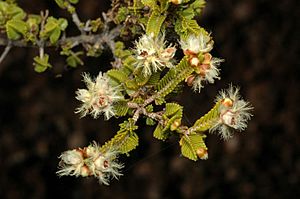Verticordia decussata facts for kids
Quick facts for kids Verticordia decussata |
|
|---|---|
 |
|
| Scientific classification | |
| Genus: |
Verticordia
|
| Species: |
decussata
|
Verticordia decussata is a beautiful flowering plant that belongs to the myrtle family, called Myrtaceae. This plant is special because it is endemic to a specific area in the northern part of the Northern Territory in Australia. This means it naturally grows only there! It's an open, bushy plant with unique leaves and pretty cream to white flowers. These small flowers grow in spikes at the ends of its branches.
Contents
Discovering Verticordia decussata
This plant was first officially described by a botanist named Norman Byrnes in 1977. The description was published in a scientific journal called Austrobaileya. The second part of its scientific name, decussata, was suggested by Dr. Stanley Blake. He wanted to describe the plant himself, but he didn't get to finish it. The name decussata is a clue about the plant's leaves.
What the Name Decussata Means
The name decussata refers to how the leaves are arranged on the plant. They are set up in a very specific way. Imagine looking down at the plant: the leaves appear in four neat rows. Each pair of leaves grows at a right angle to the pair above and below it. This criss-cross pattern is what "decussate" means.
How Botanists Classify This Plant
When another botanist, Alex George, studied the Verticordia group of plants in 1991, he placed Verticordia decussata into a smaller group. This group is called subgenus Eperephes, and then even more specifically into section Tropica. It shares this section with two other interesting plants: V. cunninghamii and V. verticillata.
What Verticordia decussata Looks Like
Verticordia decussata is an open, spreading shrub. It has branches that grow in an irregular way. This plant can grow quite tall, reaching up to about 5 meters (about 16 feet).
Its Unique Leaves
The leaves of this plant are packed closely together on short side branches. As we learned, they are arranged in that special "decussate" pattern. The leaves are long and narrow, almost like a rectangle. They are also semi-circular if you cut them in half. Each leaf is about 1.2 to 2.5 millimeters (0.05 to 0.1 inches) long and around 0.5 millimeters (0.02 inches) wide. They feel leathery and have a small groove on their underside.
Its Pretty Flowers
The flowers of Verticordia decussata have a faint, pleasant smell. They grow in small groups where the leaves meet the stem. Each flower sits on a tiny stalk, only about 0.5 to 1.0 millimeter (0.02 to 0.04 inches) long.
The bottom part of the flower, called the floral cup, looks like half a sphere. It's smooth and doesn't have any hairs. The sepals, which are like small leaves that protect the flower bud, are white to cream-colored. They are about 4 to 5 millimeters (0.16 to 0.20 inches) long and have two or more fuzzy parts. The petals, which are the showy parts of the flower, are also cream to white. They are shaped like a wide egg and are about 2 to 3.5 millimeters (0.08 to 0.14 inches) long. The petals are joined together for about 1 millimeter (0.04 inches) of their length. They also have uneven, tooth-like edges around their top.
The style is a part of the flower that helps with reproduction. It is straight and measures about 3.5 to 4.5 millimeters (0.14 to 0.18 inches) long. It has tiny hairs just below its tip. This plant mainly blooms, or flowers, from July to November.
Where Verticordia decussata Grows
This Verticordia species is one of only three types found in the Northern Territory. The other two are V. cunninghamii and V. verticillata. You can usually find Verticordia decussata growing in sandy soils. It likes to be on or near sandstone cliffs and rocky areas. It grows in different spots between the town of Katherine and the western part of Arnhem Land. This includes areas within the famous Kakadu National Park.
Conservation Status
The Northern Territory Government has a law called the Territory Parks and Wildlife Conservation Act. Under this law, Verticordia decussata is currently classified as "least concern." This means that, for now, there are no major worries about this plant disappearing or becoming endangered. It is considered to be safe and widespread enough.
Growing This Plant in Gardens
So far, there are no known records of Verticordia decussata being grown in home gardens or being spread by people. It seems to prefer its natural habitat in the Northern Territory.

